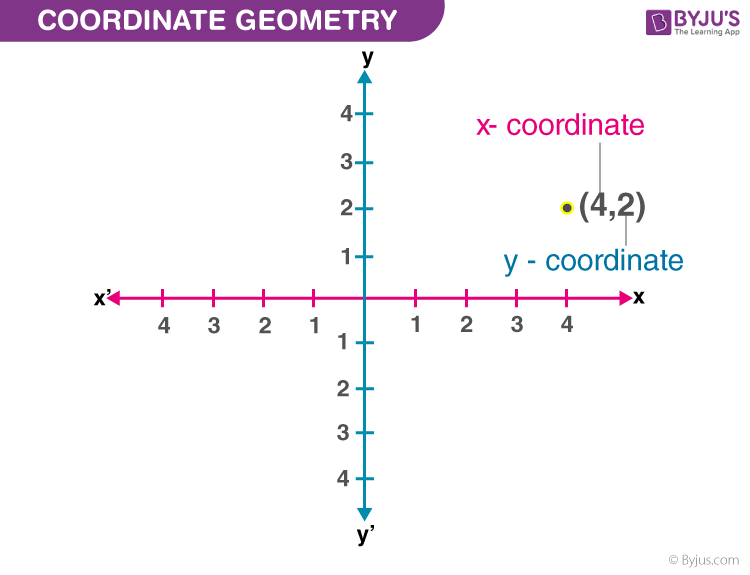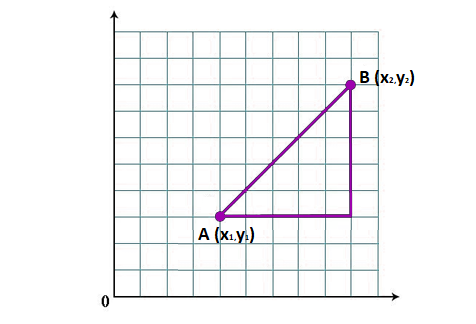Co-ordinate Geometry
Coordinate Geometry is considered to be one of the most interesting concepts of mathematics. Coordinate Geometry (or the analytic geometry) describes the link between geometry and algebra through graphs involving curves and lines. It provides geometric aspects in Algebra and enables them to solve geometric problems. It is a part of geometry where the position of points on the plane is described using an ordered pair of numbers. Here, the concepts of coordinate geometry (also known as Cartesian geometry) are explained along with its formulas and their derivations.
Introduction to Coordinate Geometry
Coordinate geometry (or analytic geometry) is defined as the study of geometry using the coordinate points. Using coordinate geometry, it is possible to find the distance between two points, dividing lines in m:n ratio, finding the mid-point of a line, calculating the area of a triangle in the Cartesian plane, etc. There are certain terms in Cartesian geometry that should be properly understood. These terms include:
| Coordinate Geometry Terms | |
|---|---|
| Coordinate Geometry Definition | It is one of the branches of geometry where the position of a point is defined using coordinates. |
| What are the Coordinates? | Coordinates are a set of values which helps to show the exact position of a point in the coordinate plane. |
| Coordinate Plane Meaning | A coordinate plane is a 2D plane which is formed by the intersection of two perpendicular lines known as the x-axis and y-axis. |
| Distance Formula | It is used to find the distance between two points situated in A(x1,y1) and B(x2,y2) |
| Section Formula | It is used to divide any line into two parts, in m:n ratio |
| Mid-Point Theorem | This formula is used to find the coordinates at which a line is divided into two equal halves. |
What is a Co-ordinate and a Co-ordinate Plane?
You must be familiar with plotting graphs on a plane, from the tables of numbers for both linear and non-linear equations. The number line which is also known as a Cartesian plane is divided into four quadrants by two axes perpendicular to each other, labelled as the x-axis (horizontal line) and the y-axis(vertical line).
The four quadrants along with their respective values are represented in the graph below-
- Quadrant 1 : (+x, +y)
- Quadrant 2 : (-x, +y)
- Quadrant 3 : (-x, -y)
- Quadrant 4 : (+x, -y)
The point at which the axes intersect is known as the origin. The location of any point on a plane is expressed by a pair of values (x, y) and these pairs are known as the coordinates.
The figure below shows the Cartesian plane with coordinates (4,2). If the coordinates are identified, the distance between the two points and the interval’s midpoint that is connecting the points can be computed.

Coordinate Geometry Fig. 1: Cartesian Plane
Equation of a Line in Cartesian Plane
Equation of a line can be represented in many ways, few of which is given below-
(i) General Form
The general form of a line is given as Ax + By + C = 0.
(ii) Slope intercept Form
Let x, y be the coordinate of a point through which a line passes, m be the slope of a line, and c be the y-intercept, then the equation of a line is given by:
y=mx + c
(iii) Intercept Form of a Line
Consider a and b be the x-intercept and y-intercept respectively, of a line, then the equation of a line is represented as-
y = mx + c
Slope of a Line:
Consider the general form of a line Ax + By + C = 0, the slope can be found by converting this form to the slope-intercept form.
Ax + By + C = 0 ⇒ By = − Ax – C
By = − Ax – C
or,
\(\large \Rightarrow y = -\frac{A}{B}x – \frac{C}{B}\)
Comparing the above equation with y = mx + c,
\(\large \boldsymbol{m = -\frac{A}{B}}\)
Thus, we can directly find the slope of a line from the general equation of a line.
Coordinate Geometry Formulas and Theorems
Distance Formula: To Calculate Distance Between Two Points
Let the two points be A and B, having coordinates to be \((x_{1}, y_{1})\) and \((x_{2}, y_{2})\) respectively.
Thus, the distance between two points is given as-
\(\large d = \sqrt{(x_{2} -x_{1})^{2} + (y_{2} – y_{1})^{2}}\)

Coordinate Geometry Fig. 2: Distance Formula
Midpoint Theorem: To Find Mid-point of a Line Connecting Two Points
Consider the same points A and B, having coordinates to be \((x_{1}, y_{1})\) and \((x_{2}, y_{2})\) respectively. Let M(x,y) be the midpoint of lying on the line connecting these two points A and B. The coordinates of the point M is given as-
\(\large M (x,y)= \left ( \frac{x_{1} + x_{2}}{2}, \frac{y_{1} + y_{2}}{2} \right )\)
Angle Formula: To Find The Angle Between Two Lines
Consider two lines A and B, having their slopes to be \(m_{1} \; and\; m_{2}\) respectively.
Let “θ” be the angle between these two lines, then the angle between them can be represented as-
\(\large \tan \theta = \frac{m_{1} – m_{2}}{1 + m_{1} m_{2}}\)
Special Cases:
- Case 1: When the two lines are parallel to each other,
\(\large m_{1} = m_{2}\) = m
Substituting the value in the equation above,
\(\large \tan \theta = \frac{m – m }{1 + m^{2}} = 0\)
\(\large \Rightarrow \theta = 0\)
- Case 2: When the two lines are perpendicular to each other,
m1 . m2 = -1
Substituting the value in the original equation,
\(\large \tan \theta = \frac{m_{1} – m_{2}}{1 + (-1)} = \frac{m_{1} – m_{2}}{0}\) which is undefined.
⇒ θ = 90°
Section Formula: To Find a Point Which Divides a Line into m:n Ratio
Consider a line A and B having coordinates \(\large (x_{1}, y_{1})\;\;\) & \( \;\; (x_{2}, y_{2})\) respectively. Let P be a point that which divides the line in the ratio m:n, then the coordinates of the coordinates of the point P is given as-
- When the ratio m:n is internal:
\(\large \left (\frac{mx_{2} + nx_{1}}{m + n}, \frac{my_{2} + ny_{1}}{m + n} \right )\)
- When the ratio m:n is external:
\(\large \left (\frac{mx_{2} – nx_{1}}{m – n}, \frac{my_{2} – ny_{1}}{m – n} \right )\)
Students can follow the link provided to learn more about the section formula along its proof and solved examples.
Area of a Triangle in Cartesian Plane
The area of a triangle In coordinate geometrywhose vertices are \((x_1,y_1 ),(x_2,y_2)\) and \((x_3,y_3)\) is
\(\frac{1}{2}|x_1 (y_2~ -~ y_3)~ + ~x_2(y_3~ – ~y_1)~ +~ x_3(y_1~ – ~y_2)|\)
If the area of a triangle whose vertices are (x1,y1),(x2,y2) and (x3,y3)\) is zero, then the three points are collinear.
- Important: Click here to Download Co-ordinate Geometry pdf
Examples Based On Coordinate Geometry Concepts
Examples 1: Find the distance between points M (4,5) and N (-3,8).
Solution:
Applying the distance formula we have,
\(d = \sqrt{(-3 – 4)^{2} + (8 – 5)^{2}}\)
\(\Rightarrow d = \sqrt{(- 7)^{2} + (3)^{2}} = \sqrt{49 + 9}\)
\(\Rightarrow d = \sqrt{58}\)
Example 2: Find the equation of a line parallel to 3x+4y = 5 and passing through points (1,1).
Solution:
For a line parallel to the given line, the slope will be of the same magnitude.
Thus the equation of a line will be represented as 3x+4y=k
Substituting the given points in this new equation, we have
k = 3 × 1 + 4 × 1 = 3 + 4 = 7
Therefore the equation is 3x + 4y = 7
Coordinate Geometry Questions For Practice
- Calculate the ratio in which the line 2x + y – 4 = 0 divides the line segment joining the points A(2, – 2) and B(3, 7).
- Find the area of the triangle having vertices at A, B, and C which are at points (2, 3), (–1, 0), and (2, – 4) respectively. Also, mention the type of triangle.
- A point A is equidistant from B(3, 8) and C(-10, x). Find the value for x and the distance BC.
Continue Learning
Frequently Asked Questions
What is Abscissa and Ordinates in Coordinate Geometry?
The abscissa and ordinate is used to represent the position of a point on a graph. The horizontal value or the X axis value is the abscissa while the vertical value i.e. the Y axis value is the ordinate. For example, in an ordered pair (2, 3), 2 is abscissa and 3 is ordinate.
What is a Cartesian Plane?
A Cartesian plane is a plane which is formed by two perpendicular lines known as the x-axis (horizontal axis) and the y-axis (vertical axis). The exact position of a point in Cartesian plane can be determined using the ordered pair (x, y).
Why do we Need Coordinate Geometry?
Coordinate geometry has various applications in real life. Some of the areas where coordinate geometry is an integral part include.
- In digital devices like computers, mobile phones, etc. to locate the position of cursor or finger.
- In aviation to determine the position and location of airplanes accurately.
- In maps and in navigation (GPS).
- To map geographical locations using latitudes and longitudes.